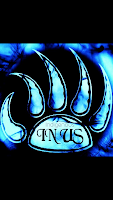 |
| Storm performing with his children |
Storm, what is your tribal affiliation?
"Meskwaki, Ho Chunk, Lakota, and I am enrolled in the Meskwaki tribe"
 |
| Storm with his mother and father |
.jpg) |
| Storm's grandmother when she was a baby |
Have you always considered yourself an artist?
"Yes"
What type of artist are you?
"Recording artist, songwriter, and oil painter "
How has being Indigenous enriched your art?
"The really great thing about Indigenous music is that it is a melting pot of a diverse range of genres: Blues, country, rock, gospel, and then I incorporate a Native influence into whatever style that I am currently recording."
Has it hurt your art in any way?
"Yes"
Please explain...
"Mostly because Indigenous or Native artists are not afforded/offered the same advantages as other Ethnic groups. For example; you can walk into any major corporate store that sells music and you will not find a 'Native Category'. The Grammy's use to have a category for Native artists, but have since removed that category and placed Native artists in the World Music category, while other ethnic groups have several different categories in which they can qualify. According to my calculations, Native artists are light years behind the rest of the world."Thank-you Storm for sharing that with me, I am able to look at it from your perspective not only as an artist but an Indigenous artist.
I must say that as a people who are native to this country, to be left out, or grouped together as if to minimize their presence in an award ceremony pertaining to music is so unfair.
Music is an essential part of a Native's being. The drum and its beat has been an inherent part of who we are as Natives since our beginning. I feel as if another important element of our Indigenousness is once again being shoved to the side.
Some things never change.
Moving on...
What type of technology do you use as an independent artist?
As an Indigenous artist I am now able to use "The Garage Band" app on my computer for my independent recordings, whereas before, I had to pay for studio time, which could get quite expensive. This past summer, someone filmed us during a festival performance and posted it on Facebook and from that we garnered several offers from various states as: Wisconsin, South Dakota, Montana, Arizona, and Oklahoma. When I first started out in this business, offers like that would not have been possible at such a quick rate and we didn't have shows like; The Voice or American Idol to help launch our career."
How has technology empowered you as an Indigenous independent artisan?
"I have the freedom to record and produce my own music the way that I think it should sound. I am currently the CEO of my own record company and so basically, I get to call the shots."
What song is your favorite to sing and why?
My favorite song is an old gospel song titled; "Drifting Too Far From the Shore". It seems to me that my voice takes on a whole different other worldly sound than when I sing secular music."
November is National Adoption Awareness Month, so I would like to shine some attention on the fact that you and your wife are not only foster parents to many Native children but have chosen to adopt a few of these precious human beings.
Why did you choose to be a foster parent to Native children and what inspired you to start adopting these children?
Storm and his children during his appearance on
Shot gun Red-filmed in Branson Missouri
"In our tribe and other Indian tribes, Native children are removed from their biological homes at an alarming rate that is completely disproportionate to other ethnic groups. My wife and I saw that there was a great need for more foster homes for Native children and in so doing, the Indian children can continue to learn about their culture which is vitally important to Indigenous peoples. Otherwise, Native children would be fostered out to non-Native homes where they would be disconnected from their own culture. Basically, I put my music career on the back burner (so to speak), because I felt that the children needed me more than my music career. In the 12 years that my wife and I have been fostering Native children, we have had almost 70 placements pass through our doors and out of those we have adopted six children. We will continue to do so as long as we are physically able."
I know that the Meskwaki tribe has been blessed to have you both in their midst. You and your wife are doing the difficult labor of love in raising these children. You have provided shelter for these precious little ones and a place they can call their forever home.
My thanks to Storm and his wife Cheryl for giving me some of their valuable time to conduct this interview. I was blessed by our conversation and filled with awe at the work they are doing with our future Native generation.
May prayer is that each child that finds shelter under your love and guidance will keep that truth in their heart, that they are worth loving and you will get back tenfold for all the time, effort, energy and love that you have given to our precious Native children.
Never stop singing Storm there will still be time for your voice and your songs to be heard.
Connect with Storm by clicking here:
https://www.facebook.com/pages/Seymour-Snow/464556586901401?fref=ts
To buy Storm's music please click here:
http://www.cdbaby.com/cd/stormseymour2
http://www.cdbaby.com/cd/stormseymour
http://www.cdbaby.com/cd/stormseymour22
http://www.cdbaby.com/cd/stormseymour3
http://www.cdbaby.com/cd/seymoursnow























